Kicked spars for rudder and elevator applications
Reusch
U.S. patent number 10,364,015 [Application Number 15/500,864] was granted by the patent office on 2019-07-30 for kicked spars for rudder and elevator applications. This patent grant is currently assigned to The Boeing Company. The grantee listed for this patent is The Boeing Company. Invention is credited to David C. Reusch.

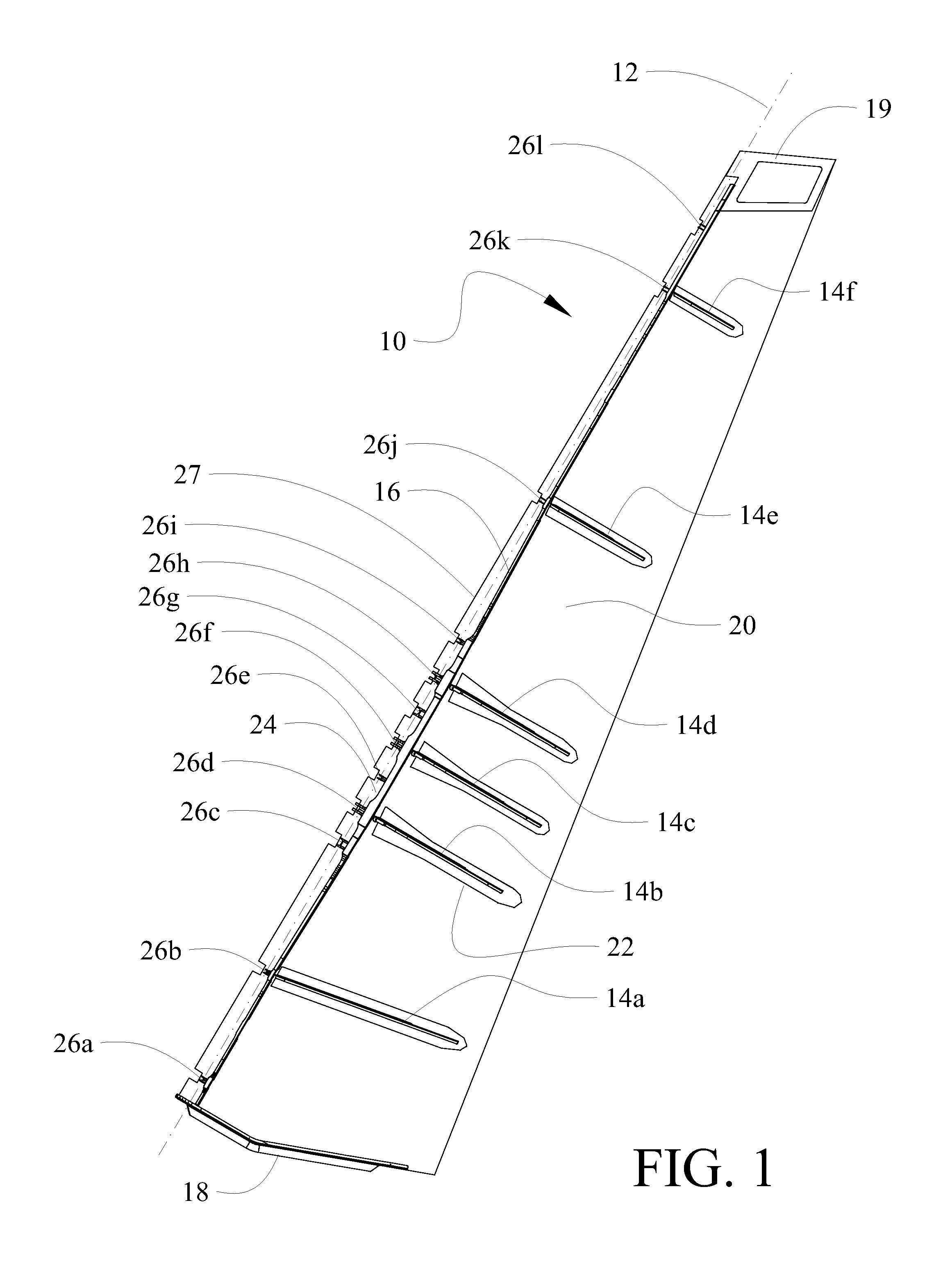
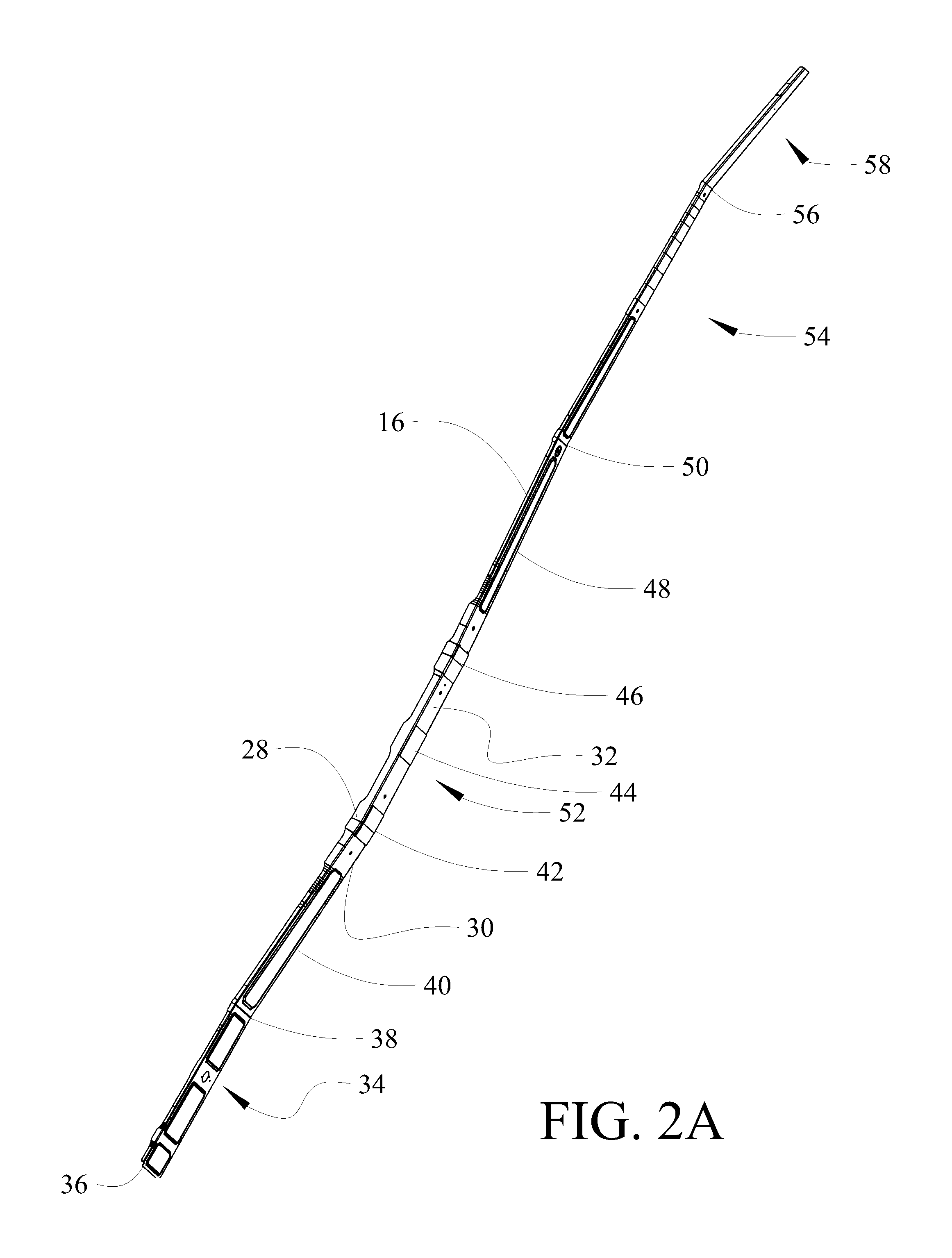



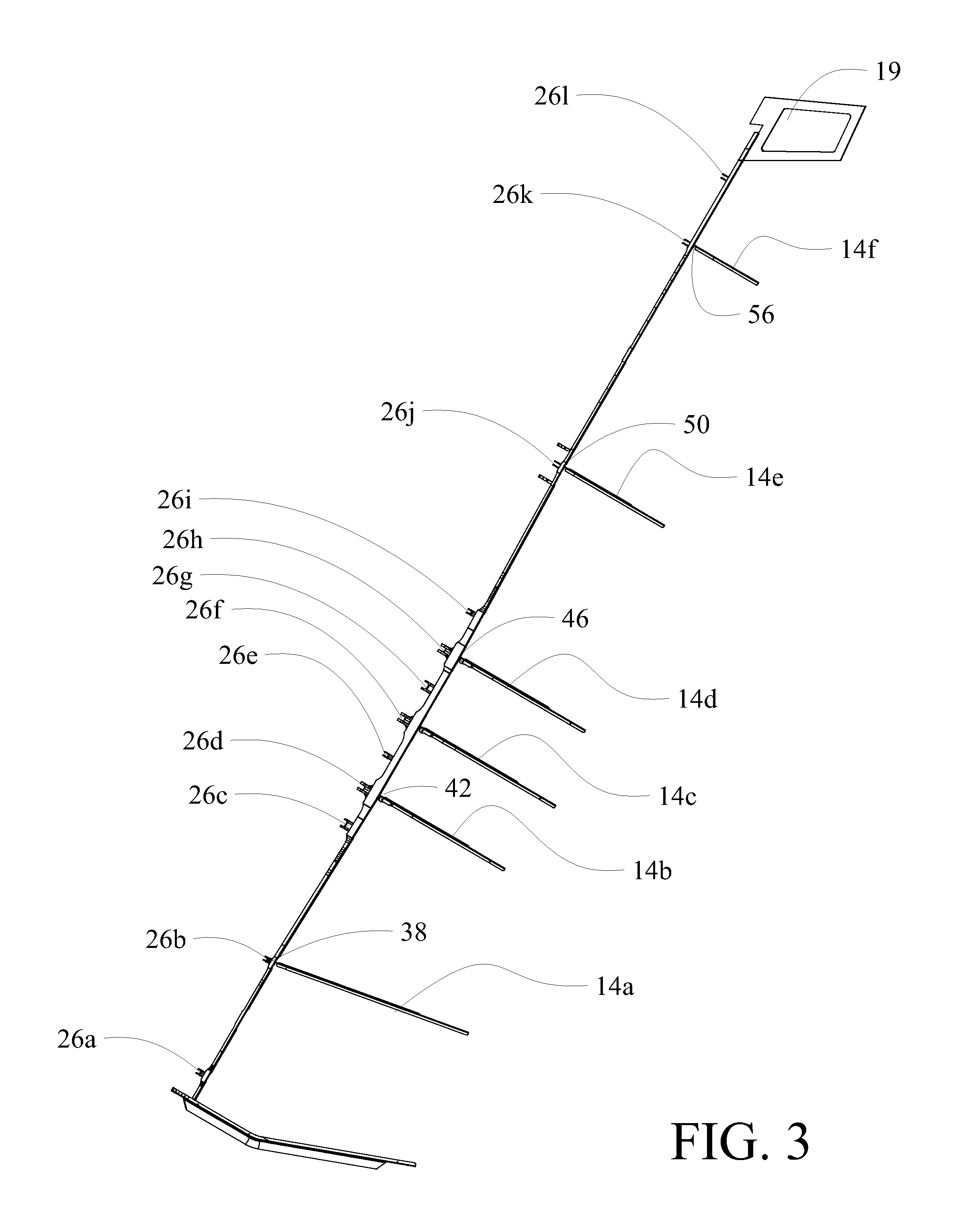


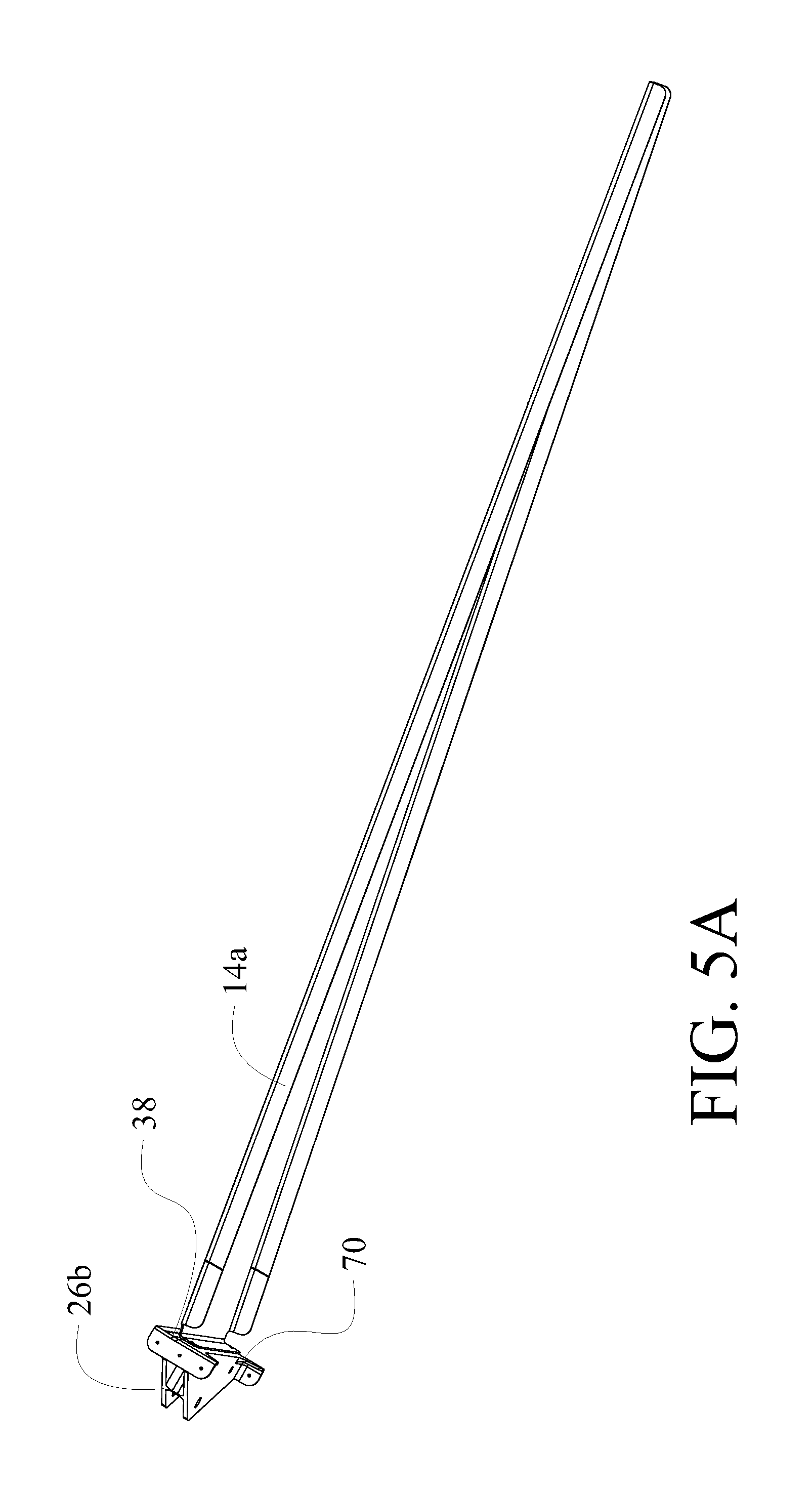
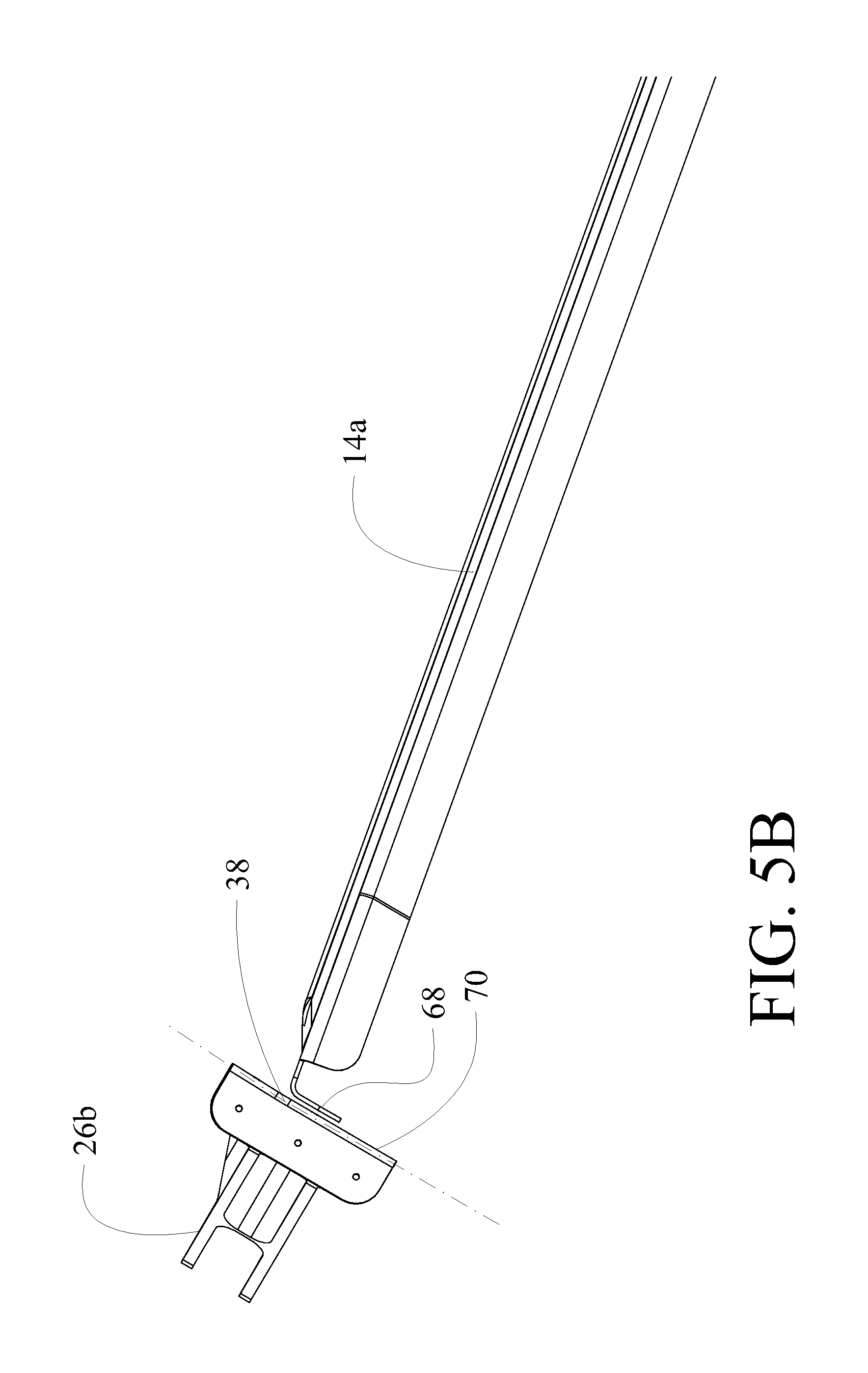

View All Diagrams
| United States Patent | 10,364,015 |
| Reusch | July 30, 2019 |
Kicked spars for rudder and elevator applications
Abstract
An aerodynamic structure incorporated in an aircraft control surface (10) provides a spar (16) extending along at least a portion of the control surface in a direction and the spar includes a plurality of bends along the direction of extension along the control surface to provide space to accommodate actuator fittings or other structural or operational requirements.
| Inventors: | Reusch; David C. (Normandy Park, WA) | ||||||||||
|---|---|---|---|---|---|---|---|---|---|---|---|
| Applicant: |
|
||||||||||
| Assignee: | The Boeing Company (Chicago,
IL) |
||||||||||
| Family ID: | 55631115 | ||||||||||
| Appl. No.: | 15/500,864 | ||||||||||
| Filed: | September 29, 2014 | ||||||||||
| PCT Filed: | September 29, 2014 | ||||||||||
| PCT No.: | PCT/US2014/058134 | ||||||||||
| 371(c)(1),(2),(4) Date: | January 31, 2017 | ||||||||||
| PCT Pub. No.: | WO2016/053259 | ||||||||||
| PCT Pub. Date: | April 07, 2016 |
Prior Publication Data
| Document Identifier | Publication Date | |
|---|---|---|
| US 20170217563 A1 | Aug 3, 2017 | |
| Current U.S. Class: | 1/1 |
| Current CPC Class: | B64C 3/185 (20130101); B64C 9/02 (20130101); B64C 5/02 (20130101); B64C 3/14 (20130101); B64C 3/18 (20130101); B64C 13/00 (20130101); B64C 2003/142 (20130101); B64C 3/00 (20130101) |
| Current International Class: | B64C 3/18 (20060101); B64C 5/02 (20060101); B64C 9/02 (20060101); B64C 3/14 (20060101); B64C 3/00 (20060101); B64C 13/00 (20060101) |
References Cited [Referenced By]
U.S. Patent Documents
| 2861758 | November 1958 | Howard |
| 2927469 | March 1960 | Czerwinski |
| 3109614 | November 1963 | Steidl |
| 4479620 | October 1984 | Rogers et al. |
| 5098043 | March 1992 | Arena |
| 2001/0017336 | August 2001 | Hirahara et al. |
| 2001/0024603 | September 2001 | Stone et al. |
| 2002/0100840 | August 2002 | Billinger et al. |
| 2006/0226291 | October 2006 | Law |
| 2009/0289147 | November 2009 | Lavaud et al. |
| 2014/0001309 | January 2014 | Tieys et al. |
| 103832576 | Jun 2014 | CN | |||
| 105366035 | Mar 2016 | CN | |||
| 1915291 | Feb 2007 | EP | |||
| 2955107 | Dec 2015 | EP | |||
| 129687 | Jul 1919 | GB | |||
| 05286496 | Feb 1993 | JP | |||
| 2000506815 | Jun 2000 | JP | |||
| 2000043796 | Feb 2002 | JP | |||
| 2014125064 | Jul 2014 | JP | |||
| 1997034733 | Sep 1997 | WO | |||
| 2013005206 | Jan 2013 | WO | |||
| WO-2013078646 | Jun 2013 | WO | |||
Other References
|
European Patent Office, "Extended European Search Report," issued in connection with European Patent Application No. 14903033.0, dated Jan. 31, 2018, 7 pages. cited by applicant . International Searching Authority, "Written Opinion," issued in connection with PCT Application No. PCT/US14/58134, dated Jul. 7, 2015, 4 pages. cited by applicant . International Searching Authority, "Search Report," issued in connection with PCT Application No. PCT/US14/58134, dated Jul. 7, 2015, 2 pages. cited by applicant . Japanese Patent Office, "Non-Final Office Action," issued in connection with Japanese Patent Application No. 2017-512924, dated Jul. 13, 2018, 9 pages. cited by applicant . Structural Design of Aircraft (First Edition), Tsuruo Torikai, Shinji Kuse, Japan Airlines Technical Association, Feb. 22, 1992, p. 158-163 and 194. cited by applicant . The State Intellectual Property Office of the People's Republic of China; "First Office Action and Search Report"; dated Nov. 1, 2018 in connection with Chinese Application No. 2014800819139; 13 pages. cited by applicant. |
Primary Examiner: Bonzell; Philip J
Assistant Examiner: Kreiner; Michael B.
Attorney, Agent or Firm: Hanley, Flight & Zimmerman, LLC
Claims
What is claimed is:
1. An aerodynamic structure for an aircraft, the aerodynamic structure comprising: a control surface; a spar extending along at least a portion of a forward edge of the control surface, wherein the spar includes a plurality of bends along a direction of extension along the control surface; and a fitting coupled to and extending from the spar, the fitting being at least one of a hinge fitting or an actuator fitting.
2. The aerodynamic structure of claim 1, wherein the plurality of bends provide an increased space between at least one of the bends and a hinge line of the control surface.
3. The aerodynamic structure of claim 2, wherein the increased space provides a connection region to accommodate the fitting.
4. The aerodynamic structure of claim 1, wherein the plurality of bends are configured to angle away from the direction of extension in a substantially aft direction and in a substantially forward direction when the spar is installed on the aircraft.
5. The aerodynamic structure of claim 1, wherein the control surface is a rudder or an elevator.
6. The aerodynamic structure of claim 1, wherein the spar includes a first region and a second region, the second region bent aft from the first region to provide a chordwise offset.
7. The aerodynamic structure of claim 6, wherein the spar includes a web, and wherein the second region is formed by a first inflection point bending the web aft from the first region, a second inflection point bending the web substantially parallel to the forward edge, and a third inflection point bending the web forward to a fourth inflection point.
8. The aerodynamic structure of claim 7, wherein, at the fourth inflection point, the web is bent substantially parallel to the forward edge.
9. The aerodynamic structure of claim 8, wherein the spar includes a third region extending from the fourth inflection point to a fifth inflection point of the web.
10. The aerodynamic structure of claim 9, wherein the fifth inflection point bends the web aft, and wherein a fourth region of the spar is defined between the fifth inflection point and an outboard end of the spar.
11. The aerodynamic structure of claim 10, wherein the second region forms a first kick in the spar and the fourth region forms a second kick in the spar.
12. The aerodynamic structure of claim 7, further including a plurality of fittings coupled to a first side of the web and a plurality of ribs coupled to a second side of the web opposite the first side.
13. The aerodynamic structure of claim 7, wherein the spar further includes an upper flange and a lower flange, the web extending between the upper and lower flanges.
14. The aerodynamic structure of claim 1, further including a rib, wherein the spar includes a web, the fitting coupled to a forward-facing side of the web and the rib coupled to an aft-facing side of the web.
15. The aerodynamic structure of claim 14, wherein the web includes an inflection point, and wherein the fitting and the rib are coupled to the web at or near the inflection point.
16. The aerodynamic structure of claim 1, further including an inboard plate and an outboard cap, the spar extending between the inboard plate and the outboard cap.
17. The aerodynamic structure of claim 1, wherein the spar has a substantially C-shaped cross-section.
18. An aerodynamic structure for an aircraft, the aerodynamic structure comprising: a control surface; and a spar extending along at least a portion of a forward edge of the control surface, wherein the spar includes a plurality of bends along a direction of extension along the control surface, wherein the spar includes a first region and a second region, the second region bent aft from the first region to provide a chordwise offset, wherein the spar includes an upper flange, a lower flange, and a web extending between the upper and lower flanges, the second region formed by a first inflection point bending the web aft from the first region, a second inflection point bending the web substantially parallel to the forward edge, and a third inflection point bending the web forward to a fourth inflection point, and wherein a profile of at least one of the upper or lower flanges is expanded in the second region relative to the first region.
19. An aerodynamic structure for an aircraft, the aerodynamic structure comprising: a control surface; a spar extending along at least a portion of a forward edge of the control surface, wherein the spar includes a plurality of bends along a direction of extension along the control surface, wherein the spar includes a web having an inflection point; a rib coupled to an aft-facing side of the web at or near the inflection point; and a fitting coupled to a forward-facing side of the web at or near the inflection point, wherein an aft surface of the fitting engaged with the web has a break angle corresponding to a bending angle of the web at the inflection point.
20. The aerodynamic structure of claim 19, wherein the rib has a forward plate engaged with the web adjacent the inflection point, such that the web is supported between the aft surface of the fitting and the forward plate of the rib.
Description
BACKGROUND INFORMATION
Field
Embodiments of the disclosure relate generally to the field of structural systems for aircraft and more particularly to spars having offset webs to accommodate fittings or other structural limitations within low profile chord designs.
Background
Widespread use of composite structural systems with their associated high strength in aircraft has allowed tailoring of very thin cross-sections in aerodynamic surfaces with spars and other structure having reduced depth. However, in many cases, structural fittings, attachment limitations or other requirements are difficult to fit within the thin sections. In actuated surfaces with high loading, excessive moment arms may be required if fittings are placed in a standard structural arrangement within the thin sections. In addition it usually advantageous to locate the spar as close to the hinge line as possible. This creates challenges when attempting to locate fittings and maintain adequate space for joints.
It is therefore desirable to provide a structural design for spars used in such thin structures which allows more room to bolt the highly loaded actuator fittings or otherwise accommodate structural requirements without compromising the actuator fitting joint, compromising the repair capability, moving the spar within the design or otherwise aggravating hinge offsets and hinge loads, or segmenting the spar.
SUMMARY
Exemplary embodiments provide an aerodynamic structure incorporated in an aircraft aerodynamic control surface. A spar extends along the entire or at least a portion of the control surface in a direction and the spar includes a plurality of bends along spanwise direction of the control surface.
The embodiments disclosed provide a method wherein a determination is made of additional space requirements for actuator fittings or other structural or operational requirements. Chordwise offset of a spar kick corresponding to the additional space requirement is established and a profile for the web in the spar with appropriate inflection points, or break points, to accomplish the necessary kick is established.
BRIEF DESCRIPTION OF THE DRAWINGS
The features and advantages of embodiments disclosed herein will be better understood by reference to the following detailed description when considered in connection with the accompanying drawings wherein:
FIG. 1 is a side view of a rudder embodiment with the near side skin removed to expose the internal structure:
FIG. 2A is a pictorial view of the spar in the embodiment of FIG. 1 with angles exaggerated for clarity;
FIG. 2B is a side view of the spar with angles exaggerated for clarity;
FIG. 2C is a side detailed view of a first region of the spar showing a first "kick" with angles exaggerated for clarity;
FIG. 2D is a side detailed view of a second region of the spar showing a second kick with angles exaggerated for clarity;
FIG. 3 is a side view of the spar, ribs and fittings of the embodiment of FIG. 1;
FIG. 4A is a pictorial view of a first example rib and fitting adjacent an intermediate inflection point of the web in the first kick;
FIG. 4B is a side view of the first example rib and fitting;
FIG. 5A is a pictorial view of a second example rib and fitting adjacent an lower inflection point of the first kick;
FIG. 5B is a side view of the second example rib and fitting;
FIG. 6 is a flow chart of a method for implementation of the embodiment described herein;
FIG. 7 is is a flow diagram of aircraft production and service methodology in which the present embodiments may be employed; and,
FIG. 8 is a block diagram of an aircraft employing the embodiments.
DETAILED DESCRIPTION
For purposes of description herein, span refers to length of the aerodynamic control surface, chord refers to width of the control surface from a leading to a trailing edge and depth refers to the thickness of the control surface at a particular combination of span and chord. In description of placement of elements terms of spanwise or chordwise location may be employed. An exemplary embodiment of an aircraft control surface employs a spar composed of a conventional C-Channel which has a "kick" (bends) at several locations allowing the chordwise offset of the spar web to be optimized or alternatively, allows optimization of the chordwise placement of the spar along the entire span of the spar. The embodiments described herein may be specifically employed in rudder or elevator applications and will be described with respect to a rudder application. The rudder spar incorporates a web that bends in the forward and aft direction, relative to an installed orientation, or installation orientation, on an aircraft, at one or more spanwise locations to provide increased space at the areas of connection to actuators that control the movable rudder control surfaces. This structural arrangement allows the spar to be placed in the optimal position at each hinge or actuator fitting for the entire span of the spar.
Referring to the drawings, FIG. 1 shows a rudder 10 with the near side skin removed to show the underlying structure. The rudder 10 attaches to a vertical stabilizer on the aircraft on a hingeline 12. The structure of the rudder incorporates a plurality of ribs 14a-14f and a spar 16 which extends in a spanwise direction from a lower (inboard with respect to the span of the rudder) end plate 18 to an upper (spanwise outboard) cap structure 19. Skins 20 cover the rudder structure. The skins 20 may incorporate laminated build ups 22, 24 at rib locations and adjacent the spar. Fittings 26a-26l are employed for engaging hinge or actuator elements for operation of the rudder 10, as will be described in greater detail subsequently. Similar structure may be employed in an elevator employing the embodiment described.
Details of the spar 16 are shown in FIG. 2A. In the exemplary embodiment, due to the size requirements of actuators for the rudder 10, a standard linear web spar could not be used unless relocated aft from a forward edge 27 of the rudder to accommodate the actuator size, which would introduce longer fittings to accommodate the further spaced hingeline from the spar and the accompanying weight increase to accommodate structural requirements of such a configuration. The present embodiment incorporates a substantially "C" shaped spar having a top flange 28 and bottom flange 30 with a web 32 extending between the flanges. A first region 34 of the spar extends from a lower extent 36 to a first inflection point 38. At the inflection point 38, a first kick is provided in the spar and the web 32 is bent to angle aft extending for a first increment 40 to a second inflection point 42 wherein the web bends again to substantially parallel the hingeline for a second increment 44. At a third inflection point 46 the web bends to angle forward extending for a third increment 48 which terminates at a fourth inflection point 50. The first, second and third increments form a second region 52 of the spar. The aft relief of the second region 52 allows significant additional chordwise length in a connection region for mounting of actuator attachment fittings as will be described in greater detail subsequently. Upward in the drawing, outboard spanwise relative to the end plate, from the fourth inflection point the spar incorporates a third region 54 which again substantially parallels the hingeline. A second kick is provided in the exemplary embodiment commencing further outboard at a fifth inflection point 56 where the web 32 again angles aft for a fourth region 58 terminating at the connection to the cap structure.
The angular relationships of the 5 regions (angles have been exaggerated for clarity) can be seen in the side view of FIG. 2B substantially perpendicular to the flange 28 and parallel to the web 32.
The first kick, spar second region 52, is shown in detail in FIG. 2C. As best seen in FIG. 2C, the profile of flange 28 (and flange 30 hidden in the view of FIG. 2C) may be modified to provide additional chordwise length for structural enhancement or to provide coverage for fittings. For the embodiment shown, flange 28 is expanded, to establish an expanded profile, between the second the third inflection points 42, 46 forming the second increment 44 of the kick forming second region 52 with the expansion extending partially into the first and third increments 40, 48 proximate the second and third inflection points 42 and 46. Extended expansion areas 60a, 60b and 60c at the locations of the fittings 26d, 26f and 26h accommodate structural requirements for those fittings (shown in FIGS. 1 and 3). The spar can have any number of kicked regions to accommodate actuator, fitting or other hardware sizing designs while maintaining a desired overall chordwise length of the mating control surfaces.
The second kick, the spar fourth region 58, is shown in detail in FIG. 2D. As in the first kick, the flange 28 (and flange 30 hidden in the view of FIG. 2D) is expanded, to establish an expanded profile. However, the expansion covers the entire forth region 58 of the kick with the expansion extending partially into the third region 54 proximate the fourth inflection point 56. Expansion of the flange 28 over the forth region 58 as flange portion 62 provides additional structural capability for the upper end of the rudder 10 to accommodate the fittings 26k and 26l as well as the upper cap structure 19 (seen in FIGS. 1 and 3). Expansion of the flange 28, or flange 30, can occur at any location along the spar to accommodate actuator, fitting or other hardware sizing designs while maintaining a desired overall chordwise length of the mating control surfaces.
FIG. 3 demonstrates the interrelated locations of the spar 16, fittings 26a-26l and ribs 14a-14f in the rudder. Each of the ribs 14a-14f is placed adjacent an inflection point, or break point, in the spar web 32 bounding the regions of the spar providing the kicks. Fittings 26b, 26d, 26f, 26h, 26j and 26k are positioned to directly correspond with an associated one of the ribs. The combined rib and fitting attachment at adjacent the inflection points enhances the structural capability of the kicks in the spar. As seen in FIGS. 4A and 4B, as exemplary of the ribs in the third increment 44, rib 14d provides support for the chord profile while employing a forward cap 64 to support the web 32 of the spar at the fourth inflection point 46. Fitting 26h incorporates an aft surface 66 having a break angle corresponding to the web bend angle at the fourth inflection point 46 thereby supporting the web 32 at the inflection point by supporting the web between the aft surface 66 and forward cap 64 of the rib 14d. As noted previously, the size and function of fitting 26h and its associated interrelated components established the initial need for the kick, providing additional chordwise space for the actuator while maintaining the spar 16 closer to the hingeline coupling the rudder to the vertical tail. A similar configuration is present at rib 14b with fitting 26d at the second inflection point 42 initiating the third increment 44 of the spar forming the aft portion of the kick. Fittings 26d and 26h are longer in the chordwise direction than, for example, fitting 26b, to position the fitting hinge through-hole at the hingeline. Similar structure incorporating the embodiment described may be employed in an elevator.
An interchangeable embodiment provides a fitting 26a-26k coupled to the web 32 without a rib 14a-14f sandwiching the web 32, or alternatively, a rib 14a-14f coupled to the web 32 without a fitting 26a-26k sandwiching the web 32, each of which by themselves structurally supports a bend in the spar 16.
Similarly as shown in FIGS. 5A and 5B, rib 14a and fitting 26b engage the web 32 at the first inflection point 38. Rib 14a incorporates a forward angle plate 68 which engages the web 32 adjacent the inflection point and fitting 26b includes an aft surface 70 having a break angle corresponding to the web bend angle at the first inflection point 38 thereby supporting the web 32 at the inflection point by sandwiching the web between the aft surface 70 and forward angle plate 68 of the rib 14a. This configuration enhances the structure at the initiation of the kick at inflection point 38. A similar configuration is present at rib 14e with fitting 26j for the final inflection point of the first kick.
The embodiment disclosed for a kicked spar allows integration of fittings or other structural requirements that would otherwise require relocating of the spar or other structural modification. A method for implementation of a kicked spar is shown in FIG. 6 wherein a determination is made of additional chordwise length requirements for actuator fittings or other structural or operational requirements, step 602. A spar kick providing an offset corresponding to the additional chordwise length required is established, step 604 and a web profile with appropriate inflection points is established, step 606. Fittings and/or ribs are located adjacent the inflection points to support the kicked web profile, step 608, with the web supported between an aft surface of the fitting and a structural cap or plate on the rib. Flanges on the spar are expanded in the region of the kicked web, step 610, to establish an expanded profile for structural enhancement.
Examples of the disclosure may be described in the context of an aircraft manufacturing and service method 700 as shown in FIG. 7 and an aircraft 802 as shown in FIG. 8. During pre-production, exemplary method 700 may include specification and design 704 of the aircraft 702 and material procurement 706. During production, component and subassembly manufacturing 708 and system integration 710 of the aircraft 802 takes place. Thereafter, the aircraft 802 may go through certification and delivery 712 in order to be placed in service 714. While in service by a customer, the aircraft 802 is scheduled for routine maintenance and service 716 (which may also include modification, reconfiguration, refurbishment, and so on).
Each of the processes of method 700 may be performed or carried out by a system integrator, a third party, and/or an operator (e.g., a customer). For the purposes of this description, a system integrator may include without limitation any number of aircraft manufacturers and major-system subcontractors; a third party may include without limitation any number of venders, subcontractors, and suppliers; and an operator may be an airline, leasing company, military entity, service organization, and so on.
As shown in FIG. 8, the aircraft 802 produced by exemplary method 700 may include an airframe 818 with a plurality of systems 820 and an interior 822. Examples of high-level systems 820 include one or more of a propulsion system 824, an electrical system 826, a hydraulic system 826, and an environmental system 830. Any number of other systems may be included.
Apparatus and methods embodied herein may be employed during any one or more of the stages of the production and service method 700. For example, components or subassemblies corresponding to production process 708 may be fabricated or manufactured in a manner similar to components or subassemblies produced while the aircraft 802 is in service. Also, one or more aspects of the apparatus, method, or a combination thereof may be utilized during the production stages 708 and 710, for example, by substantially expediting assembly of or reducing the cost of an aircraft 802. Similarly, one or more of apparatus embodiments, method embodiments, or a combination thereof may be utilized while the aircraft 802 is in service, for example and without limitation, to maintenance and service 716.
The examples described herein provide structure for aircraft control surfaces such as rudders and elevators. An aircraft 802 employing the embodiments provides enhanced operation by allowing the additional chordwise space for actuators or other requirements while maintaining the spar 16 closer to the hingeline coupling the control surface, the rudder or elevator in the described embodiments, to the associated vertical or horizontal stabilizer. In operation of the aircraft a hinge line actuator is actuated for movement of a control surface wherein the control surface incorporates a spar having a web with at least one kick bending at inflection points to provide a region having additional chordwise offset from a forward edge of the control surface to accommodate the hinge line actuator as defined for the presently described embodiments. The movement of the control surface is employed for aerodynamic control by inducing yaw or pitch for the described embodiments of a rudder or elevator.
Having now described various embodiments in detail as required by the patent statutes, those skilled in the art will recognize modifications and substitutions to the specific embodiments disclosed herein. Such modifications are within the scope and intent of the present disclosure as defined in the following claims.
* * * * *
D00000

D00001

D00002

D00003

D00004

D00005

D00006

D00007

D00008

D00009

D00010

D00011

D00012

XML
uspto.report is an independent third-party trademark research tool that is not affiliated, endorsed, or sponsored by the United States Patent and Trademark Office (USPTO) or any other governmental organization. The information provided by uspto.report is based on publicly available data at the time of writing and is intended for informational purposes only.
While we strive to provide accurate and up-to-date information, we do not guarantee the accuracy, completeness, reliability, or suitability of the information displayed on this site. The use of this site is at your own risk. Any reliance you place on such information is therefore strictly at your own risk.
All official trademark data, including owner information, should be verified by visiting the official USPTO website at www.uspto.gov. This site is not intended to replace professional legal advice and should not be used as a substitute for consulting with a legal professional who is knowledgeable about trademark law.